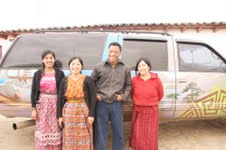Chilean duo Carlos Herrera –Co-Executive Director of Education Without Borders International– and Maria Jose Calderon –an award-winning documentary filmmaker and journalist– embarked on a 6-month road trip from California to Chile in El Chaski, “a ’95 Chevy Suburban 6.5L Turbo Diesel 4×4 that has been modified to run on Waste Vegetable Oil (WVO), Straight Vegetable Oil (SVO) and biodiesel as well as regular diesel.”
The project behind this journey had three main components:
1. Travel from California to Chile using renewable biofuel in their biodiesel vehicle, ‘El Chaski’, modified to run on waste vegetable oil.
[…]
2. Create interesting multimedia curriculum to engage youth throughout the Americas in the ever-growing dialogue on environmental and human sustainability.
[…]
3. Build an online network of grassroots communities, youth, educators and more – working together to create a future we can share sustainably with the planet.
Carlos and Maria Jose documented and shared their experiences through videos, pictures and blogging under a section on the site called “Diary.” The blog's main page describes what this diary is all about:
We want to know what Latin America is doing to find sustainable solutions to the problems and issues they face.
Through digital storytelling (photo, sound and video) we will highlight the stories of non-profit organizations, cooperatives and activists working towards sustainability; thus awakening the connections between our cultures, struggles and traditions.
Using Google Maps the travelers tracked their journey so that readers could see exactly where they were. The trip started on November 17, 2009 and less than a month after that, on December 11, they had already traveled 2,909 miles (4,681 km). On that day they wrote:
I won’t bore you with details leaving California, but we drove the southern length of the state and successfully crossed the border in Tijuana. Step one, check. Step two, ohh $h!t. It was suddenly, really happening. All the plans, all the support, the goodbyes, good luck and so on, were coming into fruition.
Although they reached Chile on June 4, 2010 their latest entry is from April 6. With 9,832 miles (15,823 km) on El Chaski, Carlos wrote:
Majo [Maria Jose] and I crossed the border into a new country for the 10th time in 5 months. It’s a special sensation crossing into the unknown. You learn to confront life’s necessities, or in our case, the necessities of international travel. Venezuela was a case study with interesting variables that could throw a monkey wrench in your equation at any time. There are basically three main areas you must cover; who, what and where? You never know whom you will encounter along the road, what you are going to eat or where you will end up sleeping.
[…]
The next chapter in our trans-continental journey – Brazil.
A crucial part of this project is the educational component. On a special section called “Education,” educators and parents can access videos and information to educate children about the environment and Latin America. Maria Jose and Carlos explain how this initiative is also an experiment in using mobile technology in education:
Not only are we creating rich educational content for use in classrooms, we are exploring the reaches of mobile technology in the field of education. With cellular phones sponsored by Nokia and the Pearson Foundation, we are engaging youth throughout Latin America to find out what they think with regards to environmental issues and more. Check out our Mobile Classroom to hear what youth are saying.
Most of this educational material comes from a section dedicated to each country the couple visited on their journey. The country sites are still a work in progress –much like the rest of the site, which grows as they add entries and information– but they all include key facts on the country, and some sites already have videos showcasing grassroots initiatives to protect the environment. The description of this section serves as a good summary of the project as a whole and the impact they hope it will have:
From north to south, we have searched for these communities and done our best to document some of these stories and publish them in a way that they may be shared, provide us with useful information, educate and hopefully inspire us all to look for ways to play our part in leaving a lighter footprint on the earth.
Hopefully our children and grandchildren will enjoy and witness the beauty and gifts the earth has provided us with.









